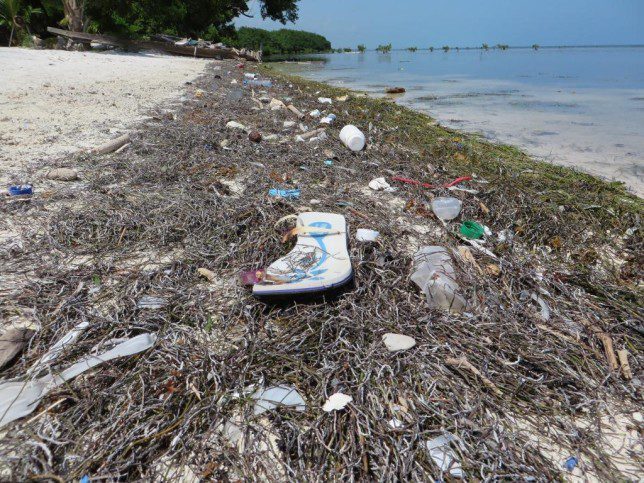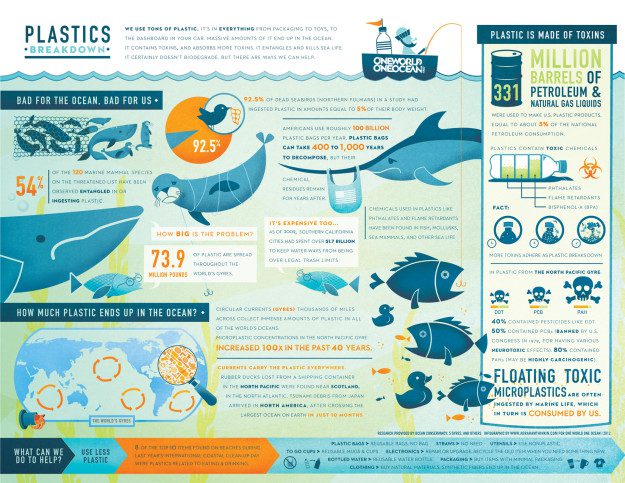Let’s set the scene, we’re on a beautiful white sand beach, dotted with palm trees; a remote tropical paradise, miles away from human habitation. As the tide retreats what’s that left behind in the strandline? Intermixed with the usual bits of seagrass and algae is a band of washed up discarded plastic. It’s a problem which faces us here at Bacalar Chico dive camp in Belize and unfortunately it is a story played out all over the world.
[Tweet “Let’s set the scene, we’re on a beautiful white sand beach…”]
As much as 1.6 billion pounds of plastic ends up in the ocean each year! Due to the very nature of plastic, it does not biodegrade meaning plastics can remain in the ocean for many decades. With the action of sunlight and waves plastics fragment into ever smaller pieces- but do not disappear. Here they are able to accumulate in our oceans, being carried by the currents and concentrated where these currents meet- known as ocean gyres. There are five gyres worldwide of which the most well researched in terms of plastic pollution is the North Pacific Gyre. Here there is so much litter it has coined the term the ‘Great Pacific Garbage Patch’ and spans an area twice the size of Texas.
This is just the plastic we can see, what about the objects we can’t? Studies have revealed plastic debris even in the deep sea, many hundreds, even thousands of meters below the surface. As plastics break up they form ‘microplastics’, these are small pieces less than 5mm in size making them unseen to the naked eye. Plastic micro-beads are added to cosmetics, such as face and body washes and tooth pastes; washing ourselves in plastic surly can’t good for our health, but furthermore these particles cannot be extracted in water treatment plants and so enter freely into rivers and oceans. Due to their tiny size, microplastics are often overlooked; however they can be so numerous that in some places they outnumber plankton by as much as 6 to 1!
This poses threats to marine life; larger animals mistake plastic particles for food. 44% of all seabirds and 22% of cetaceans (whales and dolphins), all turtle species and a growing list of fish have been documented to consume plastic. One poignant example of a dead albatross chick from Midway Island, a remote location in the North Pacific, was found to have eaten a large piece of plastic engraved with a serial number tracing it to a US bomber that crashed into the sea in 1944, highlighting the longevity of plastic debris in the oceans. The plastic content of Laysan Albatross chicks has increased ten-fold in the last forty years, in line with the increase in the amount of rubbish in the Pacific. A pygmy sperm-whale stranded in Texas was found to have its stomach blocked by plastic debris, and there are countless other examples of marine life ingesting plastic debris. Whales and turtles may take in plastic accidentally while feeding, however there are signs that they may target plastics deliberately, perhaps mistaking them for prey items, such as jellyfish in the case of turtles. Plastics present another threat to marine creatures in that they may wrap around their limbs or necks constricting them as they grow or try to move.
As plastics float in the ocean they act as sponges for contaminants such as PCBs, DDT and other pesticides. These contaminants can be up to one million times more concentrated in plastics than in the surrounding seawater. When marine organisms ingest plastic particles these contaminants can be transferred to their tissues. This is a concern as they may potentially enter our bodies when we eat seafood.
After all a little change by everyone is more effective than one person changing everything, and every step is one in the right direction.It may all seem like doom and gloom, but there are a number of things we can do to tackle marine plastics. To combat the problem it is essential to prevent any more plastics from reaching the ocean. If we all follow a few simple steps, such as the ‘4 R’s’: Refuse, Reduce, Re-use and Recycle, we can help make a difference. For example, avoid buying food wrapped in multiple packaging and using single use plastic bags, opt for cloth shopping bags and reusable food containers and drinks bottles. Choose cosmetics which contain natural biodegradable exfoliants (such as apricot stone or coconut husk) rather than plastic micro-beads. Ensure plastic waste is disposed of correctly, place it in bins and recycle where possible, pick up any litter you see on beaches or whilst SCUBA diving. After all a little change by everyone is more effective than one person changing everything, and every step is one in the right direction.



